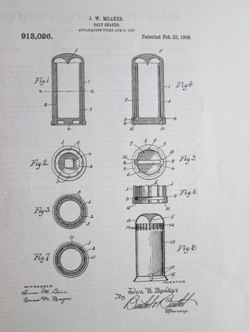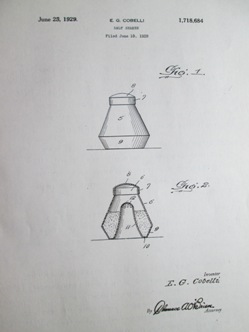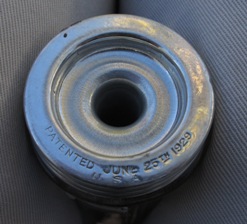Keeping Your Salt Dry: Nichols Damp Proof and Meaker Shakers
by Charity Everitt
(Reprinted from the October/December 2014 The Pioneer) Charity Everitt is a member of the ID Committee of AGSSSC and an avid researcher/contributor to The Pioneer.
People have been searching for centuries for ways to keep moisture out of their seasonings, and a good introduction to the many ideas can be found in Peterson’s Glass Salt Shakers in the sections on “Moisture Absorption” and “Moisture Exclusion.” I am limiting this excursion to two examples: (1) a Nichols Damp Proof shaker which I found in a dusty case in 2006 in New Harmony, Indiana, nestled among old razors and tiny ladies’ gloves. The bonus, carefully folded up inside, was the original instructions; and (2) patents from J.W. Meaker of Detroit, Michigan, one of whose shakers appears in Lechner III, p. 228.
Peterson (p. 76) mentions “five airtight salt shakers patented by one man in 1909.” These were patent nos. 913,025 – 913,027 for salt shakers and 913,028 and 913,029 for condiment holders issued to J.W. Meaker on February 23, 1909.
Patents 025, 026 (below) and 027 show a device in which the salt is placed in an inner receptacle closed at the bottom and is dispensed around the sides of the base by agitating the shaker . Moisture is excluded when the shaker is set on a flat surface. 027 is specifically for sheet metal construction. 028 uses a plunger device to push the salt out. Pat. No. 913,029 is the example shown in Lechner III, p. 228. It is much simpler, being just a dome with a screw-on base containing a metal tube with holes in the top. The instructions are stamped into the bottom: “Fill to mark – then screw point into salt . . . For pepper add whole rice.” The bottom also indicates “Pat Appd For.” One wonders if the other four, although patented as well, were too complex ever to be produced.

I think Lechner’s text is in error regarding the Meaker as he says “the glass top contains five perforation holes for condiment dispensing.” However Meaker’s patent clearly states numerous times that his device has an outer “imperforate casing” and permanently closed top. I also believe Lechner is mistaken in calling it a dual condiment dispenser; the instructions seem to indicate salt or pepper but not both at the same time.
The Nichols Damp Proof is similar to the Meaker shown in Lechner in that it also is just a dome with a screw-on base containing a metal tube with holes in the top (pictures below). The salt (or other powdered condiment) is intended to be placed into the outer casing and dispensed through the center tube.
The Nichols instructions (below) were printed on the small paper included in the box (described in the first paragraph of this article). A complete boxed set was recently for sale on eBay.
According to the documentation inside my salt shaker, the Nichols Damp Proof Salt Shaker (NDPSS) Co. had a factory in Jeannette, PA with a P.O. Box in Miami, FL. The bottom of the shaker is clearly stamped “Patented June 25th 1929 USA.” However, I was unable to find a patent issued on that date in the U.S. Patent Office database. Peterson mentions a similar case of a patent date on a shaker lid but finding no patent for that date; there could be various reasons for this.
It seems that NDPSS Co. made the same mechanism in varying cases: I’ve seen an egg shape with ribs, a bullet shape with various ribbed designs or without ribs, and with varying number of holes in the center tube. It is a very simple design with none of the flanges, inner/outer casings, deflectors or ejectors seen in the four Meaker patents (913,025; 913,026; 913,027; 913,028.)
The Nichols Damp Proof Salt Shaker Co. first filed as a Domestic for Profit Corporation in the State of Florida on 6/10/1930 but is no longer active. This is a year after the claimed patent date. They filed again to incorporate in Florida 3/19/32 under ID 126034; also no longer active. Another filing as Domestic for Profit Corporation in the State of Florida occurred 10/18/38 under ID 136613; also no longer active.


Lots of intriguing questions remain: Were any of the other Meaker patents ever produced? Why the multiple incorporation filings for NDPSS Co.? What is the significance (if any) of the similarity between Meaker’s 913,029 and the Damp Proof design? Why is there no evidence of the Nichols patent? Other inventors did devise moisture-proof shakers: a patent was granted to E.G. Cobelli on the same day as the Nichols patent (below), and I saw a similar design at the Artisan Center in Waynesboro, Virginia, in 2007.
The appeal of these shakers is not the beautiful art glass or the intricate surface patterns but the ingenuity that went into devising and producing solution to an ordinary household problem.
(Note: Three Nichols Damp Proof shakers are listed and pictured on our AGSSSC website: SSNOs 1116a, 1116b and 1116c. Please visit the ID Listing and Gallery Display Page 44 to learn more!)
You may also want to go to other articles in this Research Articles section on Shakers That Do Something and on the Parker NonCorrosive Salts featuring other innovative ways to avoid clumping of salt.

